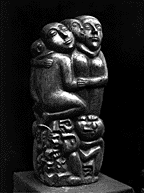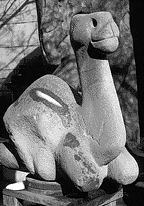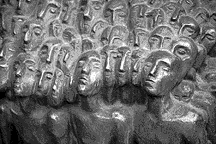|
|
 |
 |
Left: Stories of Life" (1987, Bronze).
"Each family has an ugly hidden side as well as one which
it presents to the world."
|
The greatest disappointment today is that there is no demand for seriously talented artists. Of course, this is linked with our economic situation. People aren't treating art as if it's important. For example, I don't know a single person in Azerbaijan who has a private sculpture collection.
Empty Pockets
The feeling of anticipation and expectation is one of the most
difficult experiences in life. Waiting. Waiting. We're all waiting.
It gnaws at me, preventing me from concentrating on my work.
Spiritually, it's very difficult to create in an atmosphere when
I no longer feel needed.
Most of the materials, especially bronze, that I use for sculpting
today were acquired during the Soviet period. I try to sell the
works that I created in the past. A few individuals and a few
galleries are interested. It's mostly foreigners who buy for
their own private collections.
In 1962 I joined the Artists' Union of the USSR and was able
to exhibit my work in various foreign countries-Denmark, France,
England, Cuba, and various Republics within the Soviet Union.
Today, all the doors to the international community are open,
but the pockets are empty. It's impossible for me to travel anywhere
these days. But an artist cannot live in a vacuum. We need new
impressions and new ideas, I wish I could travel just for the
sake of working and creating. Where would I go? You name it-to
any civilized country where I wouldn't have to stand in queue
for my bread. The economic situation affects all of us. In the
past, I was able to take orders and earn my living while simultaneously
continuing my more creative work. Nowadays, I continue my creative
work but the financial burdens are crushing.
I've named one of my most recent works, "Knock at the Door".
When you hear a knock at the door, you never know what will happen?
Who is knocking? Will it bring fortune or disaster? That's how
I see the period we're living in. I've designed this piece to
look something like a beetle or roach with four legs like an
animal. Obviously, the viewer asks, "What is it?" But
that's exactly the point. What is this period that we're living
in? It has so many contradictions. It's so confusing. There are
so many things happening around us that we don't understand-that
we can't explain. It's a mystery how things can be so contradictory.
How is it that we've gained independence but feel so fettered
and unfree? The contradictions are endless and they confound
us. We don't know what will emerge or what tomorrow will bring.
Fazil Najafov's studio is at Ashug Juma Street, Quarter
851 / 52. Telephone (Home): (99-412) 61-53-49; Studio: (99-412)
66-71-09.
Translation assistance from Dilara Vahabova and Jala
Garibova.
Najafov artworks |
AZgallery
Artists
From Azerbaijan International (3.1) Spring 1995.
© Azerbaijan International 1995. All rights reserved.


 Right: "Knock at the Door?" "What is
this period that we now live in? There are so many contradictions?"
One of Fazil's latest works. 1994. Photo: Oleg Litvin.
Right: "Knock at the Door?" "What is
this period that we now live in? There are so many contradictions?"
One of Fazil's latest works. 1994. Photo: Oleg Litvin.